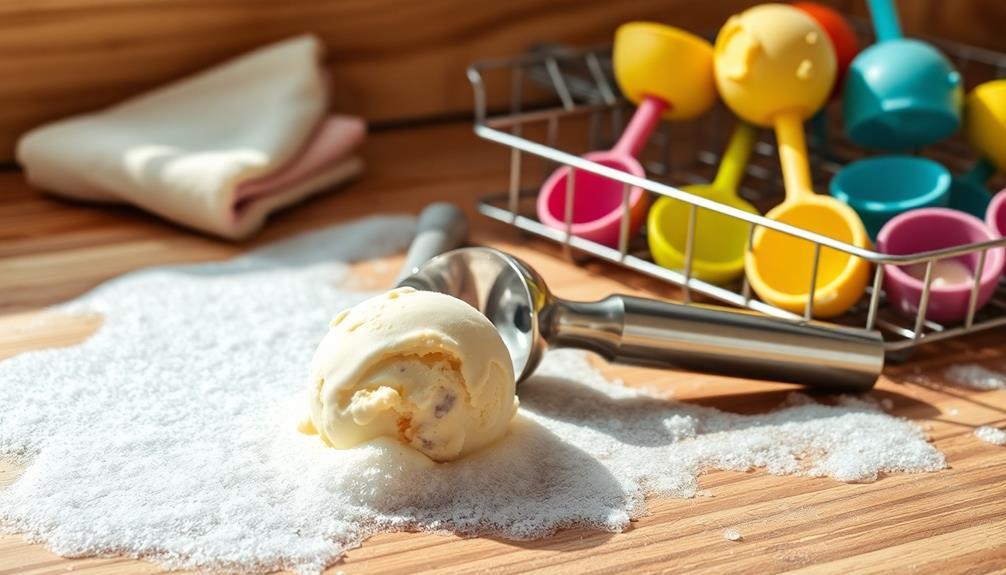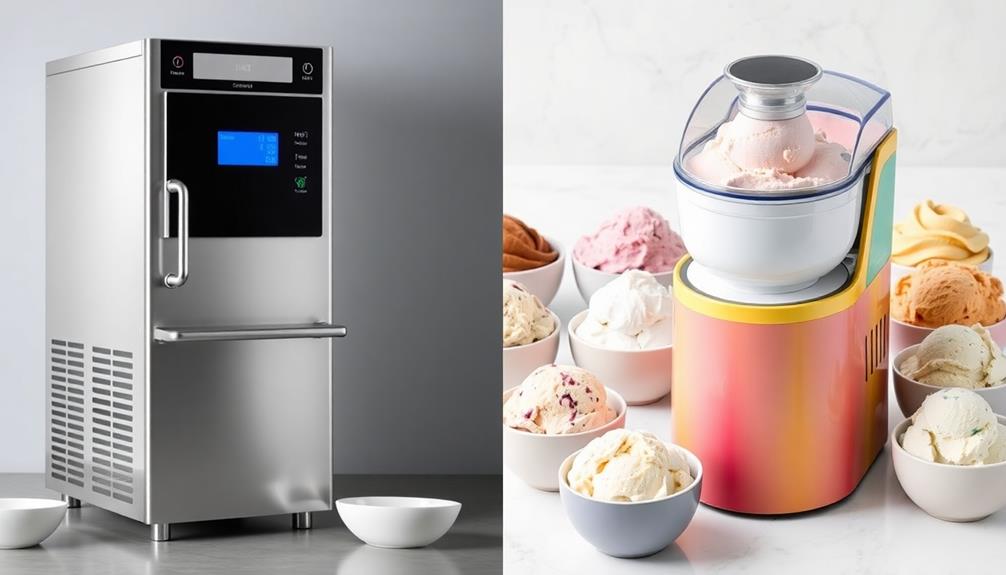To properly store ice cream and prevent freezer burn, keep it in an airtight container and seal it tightly. This limits air exposure, which causes moisture loss. Store your ice cream at the back of the freezer, away from the door, to avoid temperature fluctuations. Consider placing a piece of plastic wrap on the surface before sealing to trap moisture. Regularly check the seals on your containers to guarantee they're still airtight. Following these tips will help maintain your ice cream's creamy texture and flavor. You're just steps away from perfecting your storage techniques.
Key Takeaways
- Store ice cream in airtight containers to limit air exposure and reduce the risk of freezer burn.
- Keep ice cream in the back of the freezer for stable temperature and minimal fluctuations.
- Cover the surface of the ice cream with plastic wrap before sealing to minimize moisture evaporation.
- Maintain a freezer temperature of 0°F or colder for optimal preservation.
- Regularly check container seals and organize items to reduce door opening time.
Understanding Freezer Burn
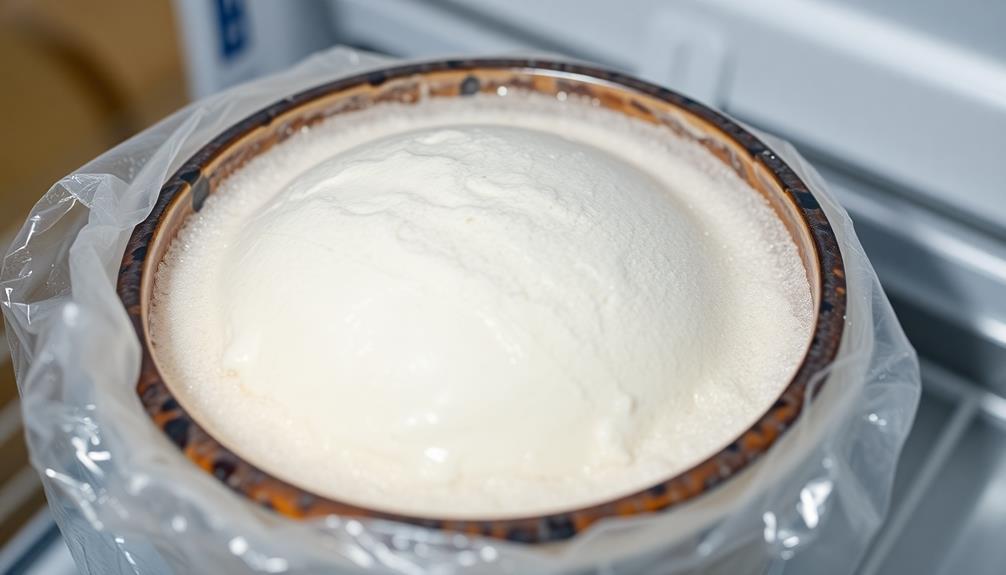
Freezer burn is a common issue that can ruin your ice cream experience. It happens when your ice cream is exposed to cold, dry air, leading to moisture loss and resulting in unsightly ice crystals on the surface.
You might notice a dry, discolored layer forming, which can make your once-smooth treat icy and crunchy, severely impacting its texture. While it's important to be aware of freezer burn, don't worry—it's still safe to consume, though it mightn't taste as good.
To maintain your ice cream's original quality, understanding freezer burn is vital. The main culprit is cold, dry air that seeps into your ice cream container.
To combat this, consider using airtight containers or filling them to the brim to minimize air exposure. Also, make sure your freezer is set to the right temperature, as fluctuations can lead to moisture loss.
Implementing these prevention techniques can help you enjoy your ice cream just as it was meant to be: creamy and delicious. By taking a few simple steps, you can keep freezer burn at bay and savor every scoop!
Signs of Freezer Burn

When you dig into a tub of ice cream, it's important to watch out for signs of freezer burn that can spoil your treat. One of the first things to look for is a top layer covered in ice crystals or frost. This often indicates moisture loss, which is a clear sign that your ice cream isn't in ideal condition.
Depending on the severity, you might see anything from minor crystals to a thick frost layer that makes the ice cream look unappetizing.
Another telltale sign of freezer burn is a change in texture. Ice cream should be creamy, but freezer-burned ice cream often becomes grainy or icy, greatly detracting from that expected smoothness.
Finally, don't overlook flavor quality. Freezer burn can lead to a bland or off taste, indicating that the ice cream has lost its deliciousness due to moisture evaporation.
To avoid disappointment, always perform a visual inspection before indulging. If you notice any of these warning signs, it might be time to rethink your ice cream storage practices.
Prevention Techniques
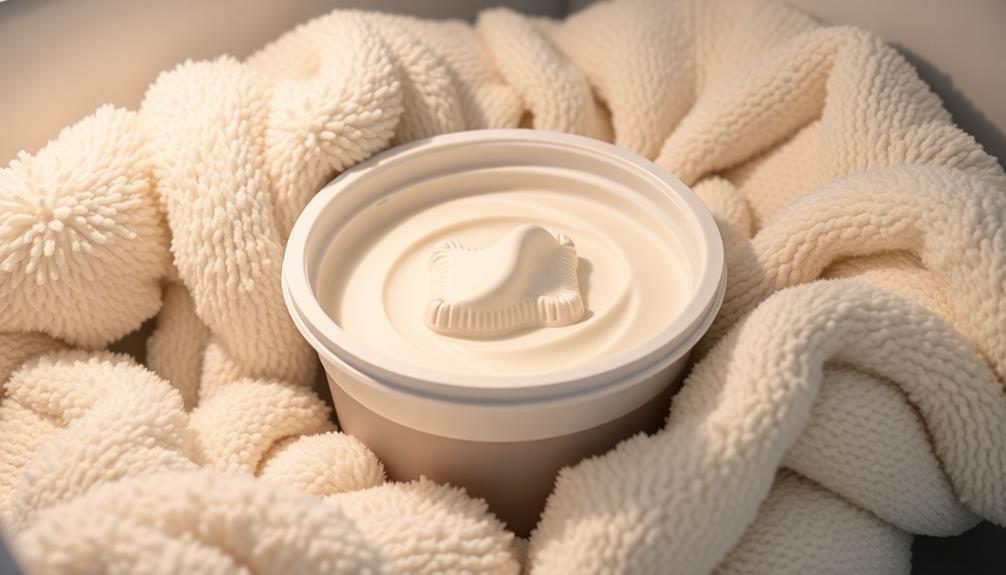
To keep your ice cream in top condition and prevent freezer burn, you can implement a few effective strategies.
First, maintain your freezer temperature at 0°F or colder. This greatly reduces the risk of freezer burn, ensuring your ice cream stays creamy and delicious.
Next, store ice cream upside down. This traps any melted moisture against the lid, preventing warm air from reaching the ice cream's surface.
Using an airtight container is essential. If you don't have one handy, tightly cover your ice cream with plastic wrap to minimize air exposure, which is a primary cause of freezer burn.
Additionally, keep your ice cream at the back of the freezer, away from the door. This placement helps avoid temperature fluctuations that can lead to freezer burn.
Proper Storage Practices

To keep your ice cream in top shape, store it in the back of the freezer where it's consistently cold.
Using airtight containers is key to preventing freezer burn, so make sure to seal them tightly.
Ideal Freezer Location
The best place for your ice cream is in the back of the freezer, where temperatures stay more stable. This perfect freezer location helps you avoid freezer burn and maintain that ideal creamy texture. Avoid placing your ice cream in the freezer door; that area experiences the most temperature fluctuations due to frequent opening, compromising the temperature for ice cream.
To enhance insulation, position your ice cream behind other items, like frozen vegetables or leftovers, creating a consistent cold environment. Here's a quick reference table for best storage:
| Location | Benefits | Tips |
|---|---|---|
| Back of Freezer | Stable temperature, minimal exposure | Store ice cream here |
| Middle Shelf | Moderate temperature fluctuations | Good for regular items |
| Freezer Door | Frequent temperature changes | Avoid storing ice cream |
| Behind Insulation | Extra protection from warm air | Use other frozen items |
Remember to perform regular checks on your ice cream containers to verify they have a secure seal. This prevents air from entering and causing freezer burn, keeping your ice cream fresh and delicious.
Airtight Container Importance
Using airtight containers is essential for keeping your ice cream fresh and preventing freezer burn. These containers considerably limit air exposure, which is a primary contributor to freezer burn. Make sure the lid fits tightly to prevent cold, dry air from entering and causing moisture loss.
Before sealing, consider covering the surface of the ice cream with plastic wrap or parchment paper. This simple step can further reduce air space and minimize evaporation, enhancing the quality of your ice cream.
Regularly check the integrity of seals on your containers; compromised seals can increase the risk of freezer burn.
For ideal preservation, store ice cream in shallow, wide containers. This shape helps maintain a more consistent temperature and reduces air exposure, further preventing freezer burn.
When you choose the right storage methods, your ice cream will remain creamy and delicious, making every scoop a treat.
Consumption of Freezer Burned Ice Cream
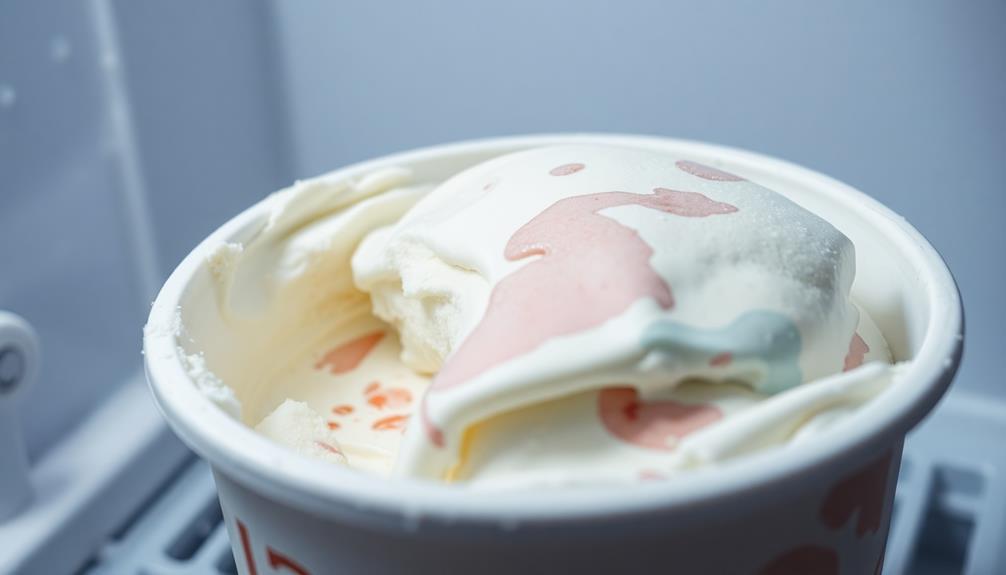
If you find freezer burned ice cream in your freezer, don't worry—it's still safe to eat.
However, the texture and flavor mightn't be as enjoyable as fresh ice cream.
You can try scraping off the top layer to improve the experience, but keep in mind that it may not fix everything.
Safety of Consumption
Many people worry about the safety of consuming freezer burned ice cream, but there's good news: it's completely safe to eat.
Freezer burn doesn't mean your ice cream is spoiled or contaminated. Instead, it simply indicates compromised texture and flavor, which can result in a less enjoyable experience.
Here are some key points to keep in mind:
- Freezer burned ice cream poses no food safety concerns.
- Scraping off the top layer may improve taste, but it won't restore the original quality.
- Proper storage can help prevent freezer burn from happening in the first place.
- If you love ice cream, you might as well enjoy it, even if it's freezer burned!
Flavor and Texture Impact
While freezer burned ice cream is safe to eat, its flavor and texture can be greatly affected. When ice cream suffers from freezer burn, you'll notice a bland or off taste due to moisture loss and the development of ice crystals. This alteration can ruin the original flavor profile you expect from your favorite treat.
Additionally, the texture becomes grainy or icy, making each bite less enjoyable than fresh ice cream.
Although scraping off the affected top layer may improve the taste and texture, it won't guarantee a return to the original quality. You might find that some unpleasant flavors still linger.
To truly savor your ice cream experience, it's crucial to store it properly to minimize freezer burn. Regularly check your ice cream storage and verify it's sealed tightly to prevent air exposure, which leads to moisture loss.
Additional Storage Tips
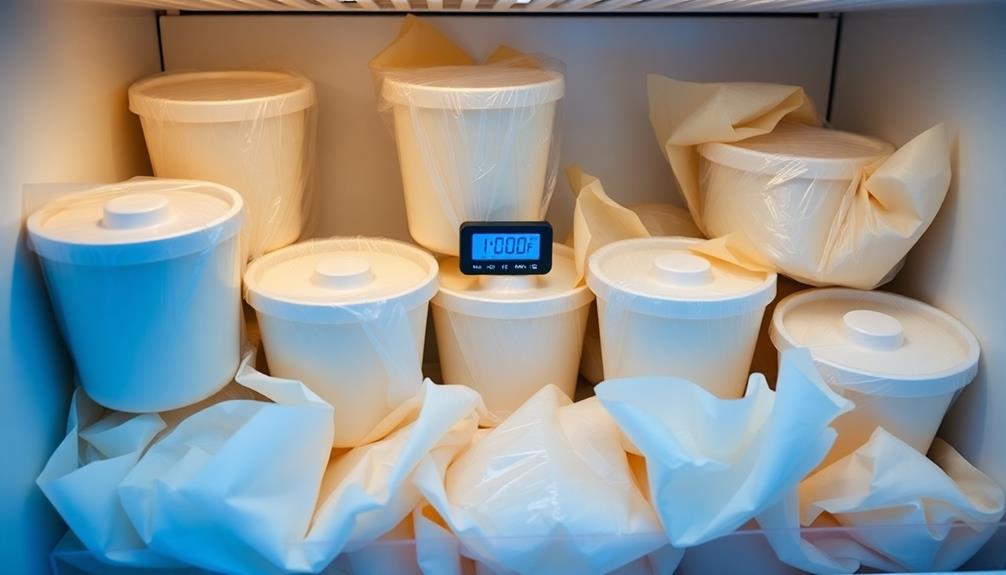
Proper ice cream storage is essential for maintaining its creamy texture and delightful flavors. To keep your ice cream fresh and prevent freezer burn, consider these additional storage tips:
- Use vacuum-sealed bags for long-term storage to eliminate air exposure.
- Regularly label containers with dates to track freshness.
- Store different flavors separately to prevent flavor transfer.
- Rotate stock in your freezer by placing newer containers behind older ones.
By following these tips, you can effectively store your ice cream and guarantee it remains delicious.
When you label containers, it helps you consume older ice cream first, reducing the risk of freezer burn. Also, keeping distinct flavors in separate containers prevents unwanted mingling of tastes.
Minimizing how often you open the freezer is key, as each time you do, warm air enters, causing temperature fluctuations that can harm your ice cream.
Frequently Asked Questions
How to Prevent Ice Cream From Getting Freezer Burn?
To prevent ice cream from getting freezer burn, store it in airtight containers, keep it at 0°F or lower, and position it at the back of the freezer, away from temperature fluctuations.
What Is the Best Way to Store Ice Cream in the Freezer?
To store ice cream effectively, keep it at the back of the freezer in an airtight container. Make sure it's tightly sealed to minimize air exposure, ensuring it stays fresh and delicious for longer.
How Do You Store Ice Without Freezer Burn?
To keep ice pristine, treat it like treasure. Seal it tight in an airtight container, chill it at zero degrees, and store it deep in the freezer—away from fickle doors and shifting temperatures.
How Long Does Ice Cream Last Before Freezer Burn?
Ice cream typically lasts up to a year in the freezer before freezer burn sets in, but homemade varieties are best enjoyed within three months. Always check for signs of freezer burn to guarantee quality.
Conclusion
Storing ice cream isn't just about keeping it frozen; it's like preserving a moment of joy. By preventing freezer burn, you're safeguarding those sweet memories, ensuring each scoop tastes as delightful as the first. Treat your ice cream like a cherished keepsake—wrap it up snugly and store it wisely. When you take the time to protect what you love, you're not just saving dessert; you're savoring life's little pleasures, one creamy bite at a time.

